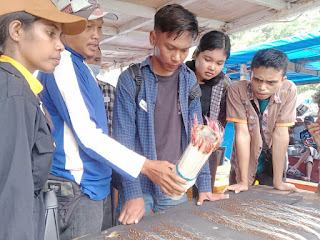Village life is often considered underdeveloped and not modern, so there are many people who choose to migrate to the city with the aim of finding work and business opportunities. If the village is developed in accordance with its superiority and functions, it can become a business opportunity such as, a tourist attraction. Rarely do people think about it, even young people now predominantly choose to live in cities because access to daily necessities is easy. It is not uncommon to find rural communities today imitating the social style of urban communities, such as the concept of houses and modern infrastructure design.
In the "Resilient Infrastructure" program, Stube HEMAT Yogyakarta provides an opportunity for participants in exposure activities to explore the unique and inspiring houses architecture having village local wisdom with resource person Ir. Eko Prawoto, M.Arch., IAI (Local Architecture-FAD UK Duta Wacana) located in Kedondong 2, Kalibawang, Kulon Progo, Yogyakarta (10/06/2023). The activity was attended by students studying in Jogja from different regions and study backgrounds.
The topic of the study visit was to initiate social values and cultural values both in the village and in the city to build of natural nuanced infrastructure, by prioritizing the wealth value and local wisdom of the village. The students learned with the resource person by observing various models of houses made from the surrounding natural material, including bamboo, stone, wood, and ceramic fragments that were arranged uniquely.
One of the participants, Daniel, brought up the fact that today's rural communities tend to follow the lifestyle of urban people including the architecture for their houses. Eko Prawoto responded that villages that are not confident in the existing culture, resulting in the culture and social values of the village that will gradually shrink and disappear. If drawn from the roots of the existing needs, actually it comes from the village, such as basic food needs, wood and stone materials for making houses. Even the existence of the city actually starts from the existence of the village, therefore the city should not be 'arrogant' towards the village instead the city should support the development the village without leaving these local values.
The development principles applied by Eko Prawoto in building his house are not far from the surrounding nature, not damage nature and still maintain the contour and authenticity of the land form by building houses following the conditions of the surrounding environment, taking raw materials from the village by prioritizing village superiority and providing opportunities for villagers to do their civil engineering and architectural skills, and empowering existing resources in the village with knowledge gained in the city that becomes a breakthrough to advance the village.
This experience of direct encounter and observation is certainly a reflection for young people for sort of infrastructure development suitable for their respective regions by considering the existing social, cultural, and human resource aspects to create works that prioritize local excellence.
Come on, young people, ignite the love for the village and the spirit to build Indonesia from villages. ***



x.jpg)
.jpg)

.jpg)




xx.jpg)






.png)
.png)






x.png)



.jpg)
y.png)
z.png)

.jpg)
.png)
.png)
.png)



















x.png)
.jpeg)

.jpeg)

x.jpg)





.JPG)



.JPG)








.jpeg)

.png)
.jpeg)
.jpg)
.jpeg)
.jpeg)
.jpeg)


.png)
.jpg)
x.jpg)
.jpg)



.jpg)





x.jpg)
.jpg)






























.jpg)





.jpg)


.jpg)







.jpg)











.png)
.png)




.jpg)




.png)










.jpg)
.jpeg)
.jpeg)






.jpeg)



.jpg)
















.JPG)



.png)







.JPG)



.JPG)


















.JPG)






.png)


.JPG)


.png)
















.JPG)


.png)
.png)


.png)






.png)

